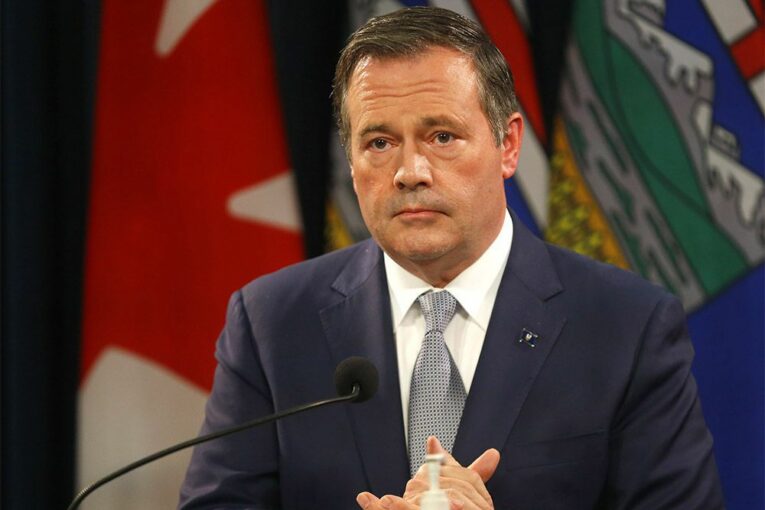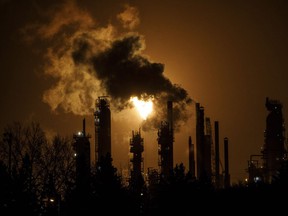
Premier Jason Kenney and his ministers will not be heading to Scotland to take part in the COP26 climate summit that begins next week.
But make no mistake, the Alberta government will be keeping a close eye on what Canada’s delegation agrees to at the international meeting in Glasgow. It comes as Alberta has plans to release a new provincial climate strategy in the coming months.
On Monday, the premier said he won’t attend the high-profile conference with the province still in a public health emergency.
“We are not travelling unless it is absolutely essential. I think just one more politician flying into a gabfest in Glasgow is not going to make any meaningful difference,” he said Monday at the legislature.
“We have expressed great concern to the government of Canada about its ever-changing (emissions) targets … What we are asking for and what the Canadian energy industry is asking for is clarity and predictability when it comes to climate policy.”
The COP26 United Nations climate change conference, which begins Sunday, will see world leaders and government officials gather for 12 days of scheduled talks.
Prime Minister Justin Trudeau, who is headed to Italy this week for a meeting of the G20, is expected to attend the first two days of the conference. Quebec Premier Francois Legault has also announced he will attend.
“We are all working with further ambition as we move forward to Glasgow,” federal Environment Minister Jonathan Wilkinson told reporters Monday.
“While Paris was about promises, I think Glasgow six years later is also about trust and delivery.”
What comes out of the meeting could be of significance to this province, which has among the world’s largest oil reserves.
At the 2015 Paris meeting, which then-premier Rachel Notley and several counterparts attended, Canada agreed to reduce the country’s greenhouse gas emissions by 30 per cent below 2005 levels by 2030.
Since then, the Trudeau government has adopted a national price on carbon and will introduce a clean fuel standard next year. In April, it announced a new goal of cutting emissions by 40 to 45 per cent by 2030 .
During the federal election campaign this summer, the Liberals promised to implement new regulations requiring petroleum producers to lower methane emissions by 75 per cent below 2012 levels by the end of the decade.
And the oil and gas industry will be given five-year climate targets from the federal government.
It’s easy to set tough goals; reaching them is the tricky part.
Between 2005 and 2019, Canada’s total emissions only dipped by 1.1 per cent, according to federal data.
The oil and gas sector will be watching the discussions up close. The Canadian Association of Petroleum Producers will be sending a small delegation to COP26, including CEO Tim McMillan.
“We should pursue an energy evolution that will allow for Canadian resources to attract investment and help meet growing global demand,” McMillan said in a statement.
The industry is making moves to lower emissions.
Oilsands producers Cenovus Energy, Imperial Oil, Suncor Energy, Canadian Natural Resources and MEG Energy formed a new alliance this year to work together to hit net-zero targets by 2050 .
Last week, the Oilsands Pathways to Net-Zero initiative released more details on achieving its target of reducing 68 megatonnes of emissions from oilsands operations.
The group says companies will use a variety of technologies to reach their objective, such as electrifying operations, improving energy efficiency and developing carbon capture, utilization and storage projects.

Kenney met with the oilsands leaders last week and said getting to their targets will require mammoth investments in technology. It will also require Ottawa’s help, including a promised federal tax credit for new CCUS developments.
“We actually need a game plan here,” the premier added. “We need to have a real dialogue with the federal government because every other month, they seem to come up with another target.”
The pressing issue is exactly how will the country achieve these national targets? The COP26 talks could provide additional clarity.
Alberta’s emissions are the highest in the country and have gone up 17 per cent since 2005.
On Monday, the British Columbia government unveiled a tougher provincial climate plan that it says will reduce emissions by 40 per cent below 2007 levels by 2030.
In Edmonton, Kenney said Alberta will be releasing its own updated climate strategy later this year.
While Alberta has targets for lowering methane emissions and a carbon pricing system for large industrial facilities, it does not have an overall emissions goal in place.
“I will not be setting a target for Alberta itself, I will be presenting a climate plan that allows our industries to reach their goals … including their net-zero goals,” Environment Minister Jason Nixon said in an interview.
“That will be in contrast to the ways the feds have done this, which is the opposite — to put a dartboard up in the minister of environment’s office and throw a dart at a target. We reject that.”
But Alberta’s plan should have specific details and timelines, with accountability mechanisms in place and sector-by-sector approaches, said Chris Severson-Baker of the Pembina Institute.
“This government doesn’t have a target, doesn’t have a plan to achieve (a) target and that doesn’t help companies in this province who are trying to figure out how to create economic opportunities or how to make good on their own net-zero plans,” he said.
Nixon pointed out the province announced plans last September to spend $750 million from its Technology Innovation and Emissions Reduction fund, which collects carbon levies from heavy emitters.
He will be announcing plans to commit about $175 million for projects that will lower emissions and create about 9,000 jobs. It will include money going into agriculture and municipal projects, oil and gas initiatives, recycling technologies and transportation.
It’s another move in a long journey for this province. The next big step could begin in Scotland in the coming days.
Chris Varcoe is a Calgary Herald columnist.
You can read more of the news on source
